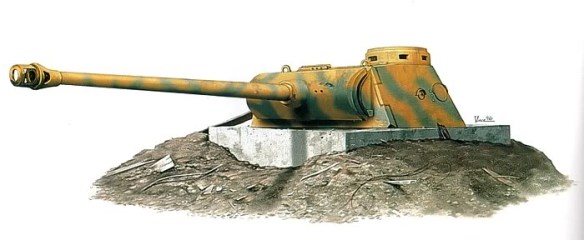According to Tom Jentz’s book, *Germany’s Panther Tank*, no less than 60 Panthers were shipped to the Leningrad front in November 1943 to serve as immobile pillboxes. Thirty apiece were given to the 9th and 10th Luftwaffe Field Divisions, and of these, ten per division were to be utilized as a reaction force, and they were left mobile; the rest were dug in. I/Pz. Rgt. 29 provided 60 volunteers to help man the runners; the extra crew members for the runners, and the crews for the pillboxes, were to be provided by the Luftwaffe personnel. On December 26th, III. SS-Panzer Korps ordered that the mobile tanks be concentrated into one ad hoc unit, leaving the dug-in vehicles where they were.
#
First from the book Tragedy of the Faithful by Wilhelm Tieke I arrive at the following.
SSPzAbt. 11 when established was to have Panthers outfitting its first company and the personnel were sent to be trained on the Panther. However there were none available so when the division went to Croatia in September 1943 they were stationed at Samobar and operated PzKpw IVs and StuG IIIs but no Panthers. While in Croatia they also used captured Italian AFVs. In December 1943, still with no Panthers, they were sent to the Leningrad Front.
At the end of 1943 SSPzAbt. 11 arrived at Hungerburg and was given a billeting area there. This city is on the Baltic coast just north of Narwa. It was then moved to Jamburg which is just to the east of Narwa. Now I will quote from the book: “Individual tank crews were issued Panthers that originated in a faulty early-production run and actually did not belong at the front. However, the marked shortage of weapons was already forcing such measures. The Panthers served as strong point at critical areas of the front, where they were dug in. The tankers of SS PzAbt. 11, who had waited in vain for their authorized issue of armored vehicles, went to work and, with the help of SS Instandesetzungs Abt. 11, made individual vehicles operational.”
From this data I then went to the book Germany’s Panther Tank, The Quest for Combat Supremacy by Thomas L. Jentz where I found the following and I quote: “Due to the mechanical unreliability of the Panther and the high rate of Panther losses on the Eastern Front, on 1 November 1943, Hitler ordered that 60 Panthers without motors and transmissions be immediately sent to the Leningrad Front to be dug in opposite the Kronstadter Bay. Between 5 and 25 November 1943, 60 operational Panthers with motors and transmissions were loaded on rail cars at the ordnance depot and shipped to Heeres Gruppe North.
On 30 November 1943, L.Armee Korps reported that the intention was to provide personnel from a Panther-Abteilung to man the 60 Panthers that were attached to the 9. and 10. Luftwaffe-Feld Divisionen. For mutual support, completely immobile Panthers were to be dug in groups of three with 1000 to 1500 meter field of fire to the front and sides. If, for tactical reasons, a single Panther was dug in by itself, it was to be supported by an anti-tank gun and infantry. The 10 most mechanically fit Panthers in each division were to be formed into two platoons of five each and held as a mobile reserve behind the front.
The 1.Abteilung/Panzer Regiment 29, selected to provide 60 personnel [20 commanders, 20 drivers, 15 gunners and 5 radio operators] to man these Panthers, arrived at the front on 19 December 1943. On 26 December 1943 the III. SS-Panzer-Korps ordered that starting 28 December, all mobile panthers were to be concentrated under I. Abteilung/PzRgt 29 as a corps reserve at Alt-Bor. The immobile Panthers and those Panthers dug in as anti-tank guns were to remain attached to the divisions.”
Now when I look at the delivery records of the Panther I cannot find any Panthers being issued to SS Panzer Abt. 11 until February 1945 when they were shipped 10 Panthers. This does not correspond to the information found in the book Tradegy of the Faithful on page 28 as noted above.
Therefore I believe that based on the text in Tragedy of the Faithful then some of these 60 Panthers sent in November were issued to SS PzAbt. 11 in late December 1943 or early January 1944. The number is not known. In Tragedy of the Faithful on page 35 it also notes that several dug in Panther were manned by personnel from SS PzAbt. 11. On page 43 it notes that SSPA 11 helped where it could with its few tanks. It lost its first men at Kaporje on 27 January. On page 55 it notes that SSPA11 broke out of Jamburg without any tanks.
These comments would further support that the initial Panthers used by the unit were part of the 60 Panthers sent in November 1943 and were both immobile and dug in and a few had been made mobile by the workshop unit of the division. It also appears that in February the SSPA11 operated in the defense of Narwa as infantry without tanks.
That about covers the data regarding SSPA 11 from beginning to end. If the Panthers that were initially used were from the 60 then these would have been the 547th through 606th delivered and would have been Ausf Ds because of the description as to their unreliability. Also the several photos of the early Panthers on the book at Narwa show the presence of a drum cupola for the commander indicating an Ausf D.
